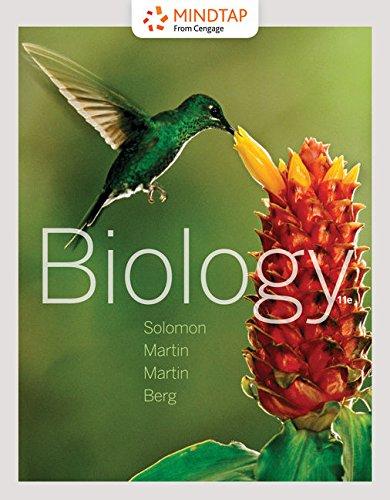
Mindtap Biology, 1 Term (6 Months) Printed Access Card For Solomon/martin/martin/berg's Biology, 11th
11th Edition
ISBN: 9781337393096
Author: Eldra Solomon, Charles Martin, Diana W. Martin, Linda R. Berg
Publisher: Cengage Learning
expand_more
expand_more
format_list_bulleted
Concept explainers
Question
Chapter 37, Problem 13TYU
Summary Introduction
To draw: The kinds of flowers that form simple, aggregate, multiple, and accessory fruits.
Concept introduction: The ovary undergoes fertilization process to produce the fruits containing one or more seeds. Fruits can be classified based upon the tissue type from which they are formed such as true and accessory fruits. Based upon the arrangement and type of the carpel present, fruits can be classified into simple, aggregate, and multiple fruits. Fruits can be either fleshy (juicy) or dry.
Expert Solution & Answer
Want to see the full answer?
Check out a sample textbook solution
Students have asked these similar questions
Standard Concentration (caffeine) mg/L
Absorbance Reading
10
0.322
20
0.697
40
1.535
60
2.520
80
3.100
Please draw in the missing answer, thank you
Please fill in all blank questions, Thank you
Chapter 37 Solutions
Mindtap Biology, 1 Term (6 Months) Printed Access Card For Solomon/martin/martin/berg's Biology, 11th
Ch. 37.1 - Prob. 1LOCh. 37.1 - Prob. 2LOCh. 37.1 - Prob. 1CCh. 37.1 - Prob. 2CCh. 37.1 - Prob. 3CCh. 37.1 - Prob. 4CCh. 37.2 - Compare the evolutionary adaptations that...Ch. 37.2 - Prob. 4LOCh. 37.2 - Prob. 1CCh. 37.2 - Prob. 2C
Ch. 37.2 - Give three examples in which the relationship of a...Ch. 37.3 - Prob. 5LOCh. 37.3 - Prob. 6LOCh. 37.3 - Explain the relationships among ovules, ovaries,...Ch. 37.3 - Distinguish among simple, aggregate, multiple, and...Ch. 37.3 - Prob. 1CCh. 37.3 - What are the main stages of eudicot embryonic...Ch. 37.3 - Prob. 3CCh. 37.3 - Prob. 4CCh. 37.3 - What are some characteristics of animal-dispersed...Ch. 37.4 - Prob. 9LOCh. 37.4 - Prob. 1CCh. 37.4 - How does early seedling development differ in...Ch. 37.5 - Explain how the following structures may be used...Ch. 37.5 - Prob. 11LOCh. 37.5 - How are rhizomes and tubers involved in asexual...Ch. 37.5 - Prob. 2CCh. 37.5 - Prob. 3CCh. 37.6 - Prob. 12LOCh. 37.6 - Prob. 1CCh. 37.6 - Prob. 2CCh. 37 - The normal order of whorls from the flowers...Ch. 37 - Prob. 2TYUCh. 37 - Prob. 3TYUCh. 37 - Prob. 4TYUCh. 37 - The process of _______________ in flowering plants...Ch. 37 - The nutritive tissue in the seeds of flowering...Ch. 37 - Prob. 7TYUCh. 37 - In plants that lack endosperm in their mature...Ch. 37 - Prob. 9TYUCh. 37 - A horizontal underground stem that may or may not...Ch. 37 - Place the following events in the correct order:...Ch. 37 - Prob. 12TYUCh. 37 - Prob. 13TYUCh. 37 - Prob. 14TYUCh. 37 - Which type of reproduction, sexual or asexual,...Ch. 37 - Prob. 16TYUCh. 37 - Prob. 17TYU
Knowledge Booster
Learn more about
Need a deep-dive on the concept behind this application? Look no further. Learn more about this topic, biology and related others by exploring similar questions and additional content below.Similar questions
- please fill in missing parts , thank youarrow_forwardplease draw in the answers, thank youarrow_forwarda. On this first grid, assume that the DNA and RNA templates are read left to right. DNA DNA mRNA codon tRNA anticodon polypeptide _strand strand C с A T G A U G C A TRP b. Now do this AGAIN assuming that the DNA and RNA templates are read right to left. DNA DNA strand strand C mRNA codon tRNA anticodon polypeptide 0 A T G A U G с A TRParrow_forward
- Please identify the curve shown below. What does this curve represent? Please identify A, B, C, D, and E (the orange oval). What is occurring in these regions?arrow_forwardPlease identify the test shown here. 1) What is the test? 2) What does the test indicate? How is it performed? What is CX? 3) Why might the test be performed in a clinical setting? GEN CZ CX CPZ PTZ CACarrow_forwardDetermine how much ATP would a cell produce when using fermentation of a 50 mM glucose solution?arrow_forward
- Determine how much ATP would a cell produce when using aerobic respiration of a 7 mM glucose solution?arrow_forwardDetermine how much ATP would a cell produce when using aerobic respiration to degrade one small protein molecule into 12 molecules of malic acid, how many ATP would that cell make? Malic acid is an intermediate in the Krebs cycle. Assume there is no other carbon source and no acetyl-CoA.arrow_forwardIdentify each of the major endocrine glandsarrow_forward
arrow_back_ios
SEE MORE QUESTIONS
arrow_forward_ios
Recommended textbooks for you
 Biology (MindTap Course List)BiologyISBN:9781337392938Author:Eldra Solomon, Charles Martin, Diana W. Martin, Linda R. BergPublisher:Cengage Learning
Biology (MindTap Course List)BiologyISBN:9781337392938Author:Eldra Solomon, Charles Martin, Diana W. Martin, Linda R. BergPublisher:Cengage Learning Biology 2eBiologyISBN:9781947172517Author:Matthew Douglas, Jung Choi, Mary Ann ClarkPublisher:OpenStax
Biology 2eBiologyISBN:9781947172517Author:Matthew Douglas, Jung Choi, Mary Ann ClarkPublisher:OpenStax
 Biology: The Unity and Diversity of Life (MindTap...BiologyISBN:9781305073951Author:Cecie Starr, Ralph Taggart, Christine Evers, Lisa StarrPublisher:Cengage Learning
Biology: The Unity and Diversity of Life (MindTap...BiologyISBN:9781305073951Author:Cecie Starr, Ralph Taggart, Christine Evers, Lisa StarrPublisher:Cengage Learning Biology: The Dynamic Science (MindTap Course List)BiologyISBN:9781305389892Author:Peter J. Russell, Paul E. Hertz, Beverly McMillanPublisher:Cengage Learning
Biology: The Dynamic Science (MindTap Course List)BiologyISBN:9781305389892Author:Peter J. Russell, Paul E. Hertz, Beverly McMillanPublisher:Cengage Learning

Biology (MindTap Course List)
Biology
ISBN:9781337392938
Author:Eldra Solomon, Charles Martin, Diana W. Martin, Linda R. Berg
Publisher:Cengage Learning


Biology 2e
Biology
ISBN:9781947172517
Author:Matthew Douglas, Jung Choi, Mary Ann Clark
Publisher:OpenStax


Biology: The Unity and Diversity of Life (MindTap...
Biology
ISBN:9781305073951
Author:Cecie Starr, Ralph Taggart, Christine Evers, Lisa Starr
Publisher:Cengage Learning

Biology: The Dynamic Science (MindTap Course List)
Biology
ISBN:9781305389892
Author:Peter J. Russell, Paul E. Hertz, Beverly McMillan
Publisher:Cengage Learning
Plant Reproduction in Angiosperms; Author: Amoeba Sisters;https://www.youtube.com/watch?v=HLYPm2idSTE;License: Standard YouTube License, CC-BY